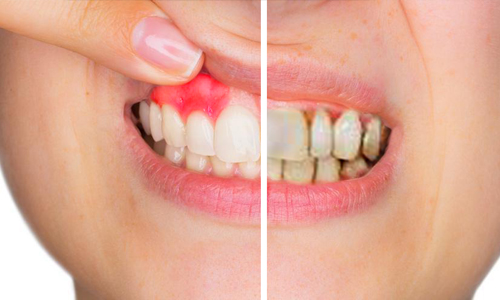What Are the Symptoms of Periodontal Gum Disease?
Gum disease or periodontitis refers to the advanced stage of infection of the soft tissues that support and surround your teeth. It is caused by the constant formation of dental plaque or a sticky bacterial film on your teeth. It is a painless, common oral health concern that is surprisingly easy to overlook. You could call it a secret agent who has snuck into your mouth. If this dental concern is not treated on time by a periodontist, you may lose your permanent teeth.
It is important to spot gum disease in its early stage to avoid serious consequences. Fortunately, if you like playing the detective role, you can look out for the signs of gum disease. Read on to learn about the signs of gum disease and how to treat early signs of gum disease.
Signs and Symptoms of Periodontal/Gum Disease:
Call us if you notice the following symptoms:
- Red or Swollen Gums: This is one of the first indications of the need for a dentist’s attention to the health of your gums. Typically, gum disease shows up as inflammation and redness along the gum line.
- Constant Foul-smelling Breath: Your mouth is a warm and wet place where millions of bacteria can happily reside. These bacteria feed on food debris and plaque inside the mouth. They may release toxins that can irritate teeth and gums and contribute to bad-smelling breath.
- Receding Gums: If you are having a longer appearance of your teeth than they used to, they are likely not growing in size, rather your gums are receding. When the jawbone starts to erode due to bacteria build-up, the attached gums may start to separate from the tooth and create a pocket in between where the dental plaque is formed. This pulling away of the gums is referred to as receding gums, which is a sign of gum disease.
- Gums that Bleed Easily: Your gums may start to feel pain, tenderness, and easily bleed while brushing or flossing.
- Wiggly or Shifting Adult Teeth: Does your smile look a little crooked lately? Gum disease can affect the jawbones that secure your teeth in place. The spread of bacterial infection inside the mouth can cause jawbone deterioration which ultimately would loosen or move your teeth. Hence, the way the teeth fit together when you bite changes.
- Teeth Sensitivity: If ice cream or a cold drink causes sensitivity, there are chances that you have gum disease. Receding gums and teeth sensitivity go hand in hand. With shrinking gums, the dentin gets exposed and the nerve endings at the base of your tooth make you feel sensitive to cold temperatures.
- Pus Formation Between Your Teeth: Gum disease is also associated with the formation of gum abscesses. This happens due to poor oral hygiene i.e. when the bacteria present inside your mouth gets built up in between the teeth and gums and forms a pus pocket.
It is possible for you to not experience any of the above-mentioned warning signs for gum disease. Hence, to rule out having it, every dentist recommends their patients visit them bi-annually for dental check-ups and also schedule periodontal examinations.
Ways to Prevent and Treat Gum Diseases
How to treat early signs of gum disease? The treatment method for gum disease depends upon the severity or progress of the condition. Good dental care is crucial to avoid worsening or recurring periodontal disease. The treatment options for the early stage of gum disease include:
- Careful, In-depth Cleaning– It is the first line of treatment wherein the periodontist makes use of special dental instruments to get rid of the bacteria that go under the gum line. The professional dental cleaning would involve scaling i.e. the scraping of the tartar/calculus both above and below the gum line and root planing i.e. smoothing out of the rough surfaces of your tooth roots which helps the gums to reattach to your tooth.
- Medications– Some prescribed medications can help treat gum disease like an antibiotic gel (to control infection of the gum pockets after deep cleaning), oral antibiotics (in severe cases), enzyme suppressants (to avoid enzymatic breakdown of gum tissues), and antibiotic microspheres/antiseptic chips (these release the drug slowly inside gum pocket to get rid of the bacteria).
- If deep cleaning and medications fail to get rid of the whole problem, you may need to go deeper. Hence, the periodontist may recommend you have:
- Laser Gum Surgery- This is an alternative to conventional gum surgery wherein lasers are used to treat the infected area by thermally destroying the bacteria and infected tissue.
- Gum Graft Surgery- In this treatment, soft tissues are taken from the mouth roof or another mouth part and covered on the exposed tooth roots to prevent jawbone loss and tooth decay and to help with teeth sensitivity.
- Gingival Flap Surgery- This involves lifting your gums to have access to deep-seated tartar i.e. under the gum line and its removal. The surgeon may stitch your gums back so they are tight around your tooth and prevent more calculus formation.
First Point Dental provides comprehensive periodontal treatment of gum disease that includes routine dental cleaning, scaling, and deep cleaning followed by gum surgery (if required).
Whether you are looking for periodontal treatment or any other dental care, our team of expert dentists can help. Call us to schedule an appointment and to keep your oral health in good shape.

